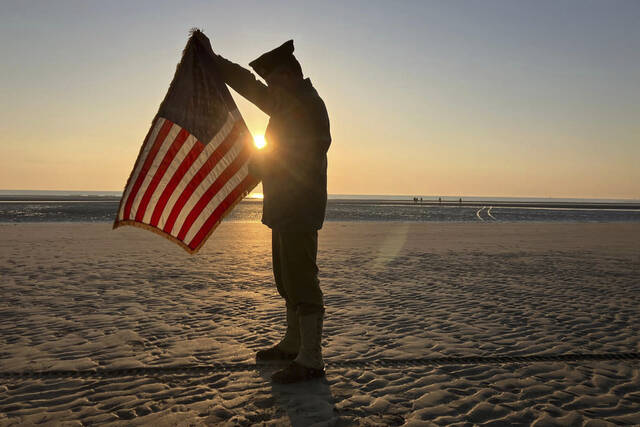Joseph Sabino Mistick: Remembering when Americans fought for freedom
As the nation remembered D-Day last week — with what was likely the last big gathering of American heroes in Normandy, France — the world was reminded of the value that America once placed on freedom.
The numbers are staggering. On June 6, 1944, nearly 7,000 Allied ships and landing craft appeared in the morning mist off the coast of Normandy, just below the guns of Adolf Hitler’s Nazi occupiers.
It was the largest invasion by sea in history, and it included 150,000 Allied infantry troops — Americans, British and Canadians. The National D-Day Memorial Foundation estimates combat deaths at 2,500 Americans and nearly 1,900 Allies. Total Allied casualties — killed, wounded and missing — are estimated at 10,000.
Many deaths occurred in the early minutes of the invasion, as the landing craft ramps fell and troops were entering the water. They were mowed down by the German machine-gunners from above the beaches.
The D-Day invasion touched families and towns across America, and tiny Bedford, Va. — a farming town of about 3,200 then — suffered the greatest per capita loss. Twenty young soldiers with the Virginia National Guard — the “Bedford Boys” — died at Normandy.
If you were born in those healing years after World War II, the ceremony at Normandy honoring the surviving heroes of D-Day was not unfamiliar. We were surrounded by those heroes and similar ceremonies growing up. That made it easier for us to understand the sacrifices that were made and the cost of freedom.
There were the burn scars of our coach who had barely escaped his exploded tank. There was the local politician with a bad limp who lost a leg in the Pacific. And there was the man down the street who shook hands with his left because he lost his right in combat. We knew the wartime experiences of many more: He was at Tarawa. He was a radioman locked in the hold at Midway. He was on a forced death march. He bailed out when his plane was shot down. He was at D-Day. Those extraordinary events were part of everyday conversation.
And kids were careful not to play too loudly outside the homes that had a gold star on a banner in the window. That gold star meant that the mother in that home had lost a child to war.
With each successive generation, there are fewer reminders of how brave Americans saved freedom and liberty for us and the world. Maybe that is why some politicians, often those who never served or lost a loved one to war, can make points by bad-mouthing America or trashing our elections and our system of justice.
And without those daily reminders of the value average Americans placed on freedom during World War II, it has been too easy to deny Ukraine the help it needed and still needs to fight Vladimir Putin’s tyranny.
Anyone who wants to know how this nation once responded to tyrants should watch the first 23 minutes of Steven Spielberg’s 1998 movie “Saving Private Ryan.” It should be required viewing at the start of every American history class.
As journalist Mark Allison wrote last week for the BBC, “On the 80th anniversary of D-Day, as these experiences slip painfully from living memory, Spielberg’s hymn to the fallen is more resonant than ever.”
And if you want to honor those Americans who have served and those who continue to fight for our freedom, be sure to vote. It is a small thing compared to what they have done.
Joseph Sabino Mistick can be reached at misticklaw@gmail.com.
Remove the ads from your TribLIVE reading experience but still support the journalists who create the content with TribLIVE Ad-Free.

